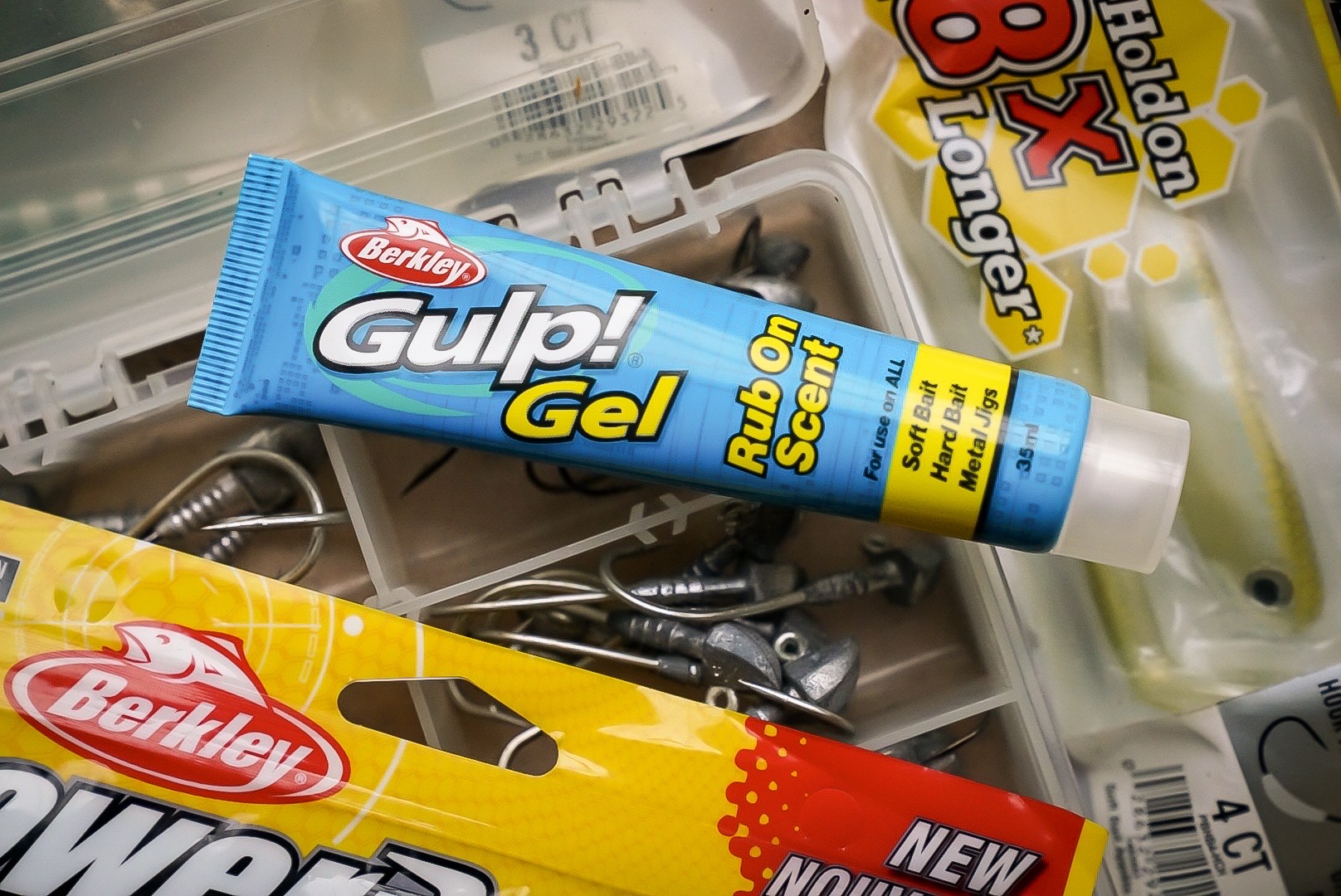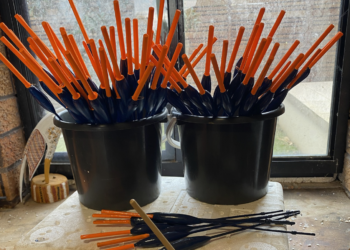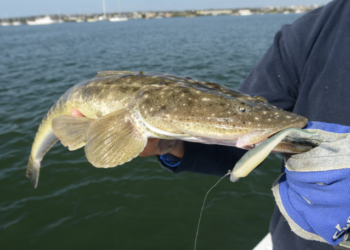
IN this article we highlight the trends in bream lure fishing that have become established and reliable options that everyone can use.
CRABS, PRAWNS AND YABBIES
Bream will pounce on a crab, prawn or yabbie so those who can replicate these baits are always likely to tempt a bream.
• Cranka Lures Crab: The Aussie designed Cranka Crab with its realistic appearance and waving nippers fools many fish by closely mimicking a crab. It is reasonably easy to fish and often does its best work with a minimal twitch, slow drag or “do nothing” retrieve. Many cast it close to structure like bridges and piles. Toss it in close, let it settle and watch for a take. It comes in several sizes ranging from a 50mm light to 85mm. Many prefer the olive, darker green and brown variants. Replacement nippers and legs are available. The “Cranka Crab” is responsible for a significant percentage of tournament captures and is a highly effective lure.

• Berkley Gulp Crabby This soft bait, a cross between a crab and yabby, is popular with some bream anglers. It has soft quivering legs and nippers that look lifelike and is cost effective when fishing in snaggy terrain where bream can reef you. Crabby comes in two, two and a half and three-inch models and can be fished deep on a heavier jig head or weightless.
• Ecogear Acqua Bream Prawn: In local canals here on the Gold Coast, this small bait is often responsible for some excellent captures. Used on a very lightly weighted jig head (1/24th – 1/40th) and thin fluorocarbon line, it is flicked in behind pontoons, jetties and other canal side structure, where it generates a strong response from bream and other predators as it settles.
Some think it targets “pet” fish residents fed with bread. Perhaps this is why the Salt ‘n’ Pepper shade and other lighter colours are popular. This lure can be pitched right into the snaggiest terrain because an angler can bust off and have another lure in play quickly. This bait is cheap and easy to use, effective and proven.

SURFACE
We’ve all seen bream attacking a wildly jumping jelly prawn. Over the past decade or so, catching them on surface has become a front-line tactic thanks to the following lures and others like them.
• Lucky Craft NW Pencil: Ten years ago, this highly respected surface lure had already caught thousands of bream. While it is now competing with many other surface lures, it remains a standout performer. At 52mm it is a small noisy bait that when twitched and paused, seems to encourage shy bream to have a crack.
• OSP Bent Minnow 76: Bream are not an easy target and getting them to take a surface lure is often quite frustrating. OSP Bent Minnow has gone a long way toward changing that. In canals, along rocky edges, over weedy flats and even in deeper channels, cast this lure out, wind it back for a metre or two then let it sit. It comes in 76, 86 and 106mm models. (The big 130mm is good on flatties too!). The hooks are deadly sharp but can be replaced with stingers. The Pink Head P74 is popular with many canal “breamers” but other colours work well too. The retrieve generates a wounded or struggling minnow profile. Some think it simulates a prawn or injured fish. Regardless, bream will sit and eyeball the stationary lure then often lose their reservations and eat it.
• Imakatsu Dilemma Popper: This lure has made a name for itself when used on canal and flats bream. It also works well on whiting over the sandflats. When retrieved as a popper, it spits a small “ball” of water. It also does well when used with a walk-the-dog style retrieve. Add plenty of pauses. Its a noisy little lure with a realistic finish. Maybe it is the “dressed” rear treble, but there is something about this little surface bait that is very enticing to bream.
• Tiemco Pencil Minnow: While it is now hard to find supplies of the classic Tiemco Red Pepper Micro topwater, the silent Tiemco Pencil Minnow can be used in its place. It’s a 40mm floater that offers a quiet, subtle profile that works when bream are not reacting to noisier baits.
SINKING STICKBAITS
• Tiemco Stick Minnow and Austackle Shinku: Both these sinking stickbaits have a good reputation particularly in clear conditions. They work well when twitched near boat hulls and over rocky or weedy flats. Species like tailor and flathead love them too and losing a few is often on the cards. The Stick Minnow in 007 is a classic colour that has caught many bream.

CRANKS
Bream will eat large baitfish. Maybe that’s why slim profile minnows dominated tackle boxes for many years. They remain very effective on bream. In more recent times fat cranks are now employed by many anglers and they work in a range of scenarios.
• Atomic Hardz Crank 38 and Jackall Chubby 38: These two “fat cranks” are proven bream takers. They are fished using fine (one or two kg) fluorocarbon trace or fluorocarbon straight through (no braid). These little round cranks get smashed regularly as they slowly tap-tap-tap across the seabed or along a rock wall. The Atomic in GGB (Ghost Gill Brown), often sells out before a competition mostly in the deep diving model. The Chubby in Brown Suji Shrimp or similar is also very popular. These lure work best slow rolled along structure and over rocky or weedy terrain.
• Imakatsu Wasp, Ecogear SX 40, Nories Laydown Minnow and Khamsin Zipbaits: These slimmer cranks and others like them have remained popular with tournament anglers. Many have developed the twitchy retrieve that unlocks bream bites along rocks walls, boat hulls and pontoons. Its possible to de-tune a Wasp (and others) to run on a bias so it tracks in under cover which can further encourage a strike from fish sheltering under cover.
• OSP Dunk 48: When bream are schooling in deeper water this deep diving crank has set a high standard for well over 15 years. It reaches down to three metres or more and is highly attractive to bream. It comes in both floating and suspending models. All colours work but the Alive Shrimp and Craw patterns remain favourites with many anglers.

BLADES
Targeting bream holding on deeper reef or structure has always been the main task for a blade style lure. Initially lures like the EcoGear VX blades and the Evergreen Little Max were the primary options.
In recent times blade options have expanded. Smaller blades in chrome, holographic finish and darker matt shades have emerged and done well. There are now quite a few brands in use.
The Ecogear VX35 and 40, TT Switchblades and Strike Pro Cyber Vibe in a range of sizes are all effective at times. Those with dangly assist hooks and feelers make them harder for a bream to pass up. Many anglers also add bait scent to increase their appeal.
PLASTICS
Over the past decade the variety of soft plastic options has increased from a few proven tails to many options. These include baits with salt additives, bio baits and strong plastic variants that last for many fish. We have come a long way from the highly effective Squidgie Wriggler (Blood Worm).
• EcoGear Grass Minnow: This soft bait in the medium size and mounted on a G Hook has caught a lot of bream when prawns are running. Its retrieved briskly on the surface then paused. The Okiami (pale pink) colour is highly rated by many anglers.
Plastics now come in a range of colours that mimic the type of food bream seek. Colours including motor oil, prawn, blood worm, wasabi, clear and black are now readily available in the right sizes and resilient or bio (Gulp) materials.
Z Man 2″ GrubZ and Berkley Gulps are a good example of the type of soft tails now in wide use. They are teamed with a light ie. 1/16th jighead. Products from manufacturers like Keitech (Easy Shiner, Shad Impact, Flappers and Spiders) demonstrate the diversity in soft baits now in use.
JIG HEADS
Along with the increased diversity in soft tails, jigheads have followed suit with some fantastic off the shelf options. TT Hidden Weight System and Berkley Nitro Bream Pro Series are excellent jig heads many rely on. These and other brands come in weights down to 1/40th in the TT and 1/50th in the Nitro. This makes finding the right presentation weight and hook size so much easier.

SCENT
In aquaculture, the trick to getting your fish to grow is to feed them regularly. Scent products are used to ensure farmed stock eat their dinner even though it comes from a bag not the sea.
While scent has been around for many years, new options are now being used on a wide range of baits including Cranka Crabs, blades and cranks. Some anglers use it sparingly, while others slather it on. It’s fair to say its part of nearly all comp anglers’ arsenals.
UV
Some anglers use lures with UV highlights to get an edge. A “black light” allows you to see if a lure has UV shading or highlights.
UV reflects well on clear moonlit nights but not so well in cloudy shallow-water conditions. Nonetheless it may offer a hot spot fish can zero in on in murky or discoloured water. The good news for those who want UV is that there are now a wider range of options in a variety of slim, fat and surface lures as well as some soft baits. The Jackal Chubby in Suji is a good example.
STRAIGHT THROUGH FLOURO
Bream are a leader shy species. Many comp anglers make every effort to minimise the impact of their connections to get a bite in tough conditions. In some applications they have given up on a braided mainline with a leader and gone for a fluorocarbon line straight through. Many anglers are using one and two kg breaking strain material and landing some big fish.
New fluorocarbon offers improved abrasion resistance, appropriate limpness and strength in low breaking strains. The inherent stretch allows the angler to stay connected to fish where a braid to leader set up is far less elastic. It is sometimes called the “bungee effect”. It suits many applications except distance casting work where fine braid excels.
Ultra light shallow spool 1-2000 sized threadlines are popular reels for this application. These are teamed up with light action 6’8″ to 7’4″ rods. Its almost impossible to break the line through these outfits which makes them very effective. Also, removing a knot from the connection is reducing the number of points of failure which is a good thing. In these breaking strains, anglers must check line regularly and put fresh line on if any doubts exist. Many think it is well worth the trouble when the fish are shy.

STINGERS AND TREBLES
Bream are notorious tail nippers. They can also swirl on a bait trying to sink it before feeding. In this environment, the angler with the right hook will get more fish.
Are the hooks sticky sharp? Do they add to the overall effect of the lure? Would changing them for stingers improve hook up rates. If so, which stinger is best? These are questions comp anglers consider when arming their lures.
In the last decade, nearly all new lures and jig heads are fitted with chemically sharpened fine wire hooks or trebles. They come in anodised black, red, green, white, silver and bronze colours. Some come with small feathers or Krystal Flash. Brands like Vanfook, Gamakatsu, Decoy, Mustad, OSP and Owner provide a variety of options.
Pairs of “stinger” or assist hooks down to size 14 are also available. Some come with feelers or legs and others with coloured braid or flash. You can buy them or make them yourself.
This has allowed anglers to modify the set up on a lure or plastic to get improved hook sets. An example might be to use red trebles on a surface lure which may prompt a bream to nip at it thinking it’s a leg. Another is the use of stingers on a soft plastic to snare tail nippers.
NEW BRAID
In some applications including long casting, braid line is still the best choice. There are some fine diameter options that offer quite incredible breaking strains and the ability to make very long casts.
Many prefer braid for surface work where casting range is important. The newer woven braids now make that easier because they are limp, slick and pliable.
SUMMARY
Consistently taking bream on lures is an ongoing challenge for many anglers. Recent trends in conjunction with a healthy competition scene has produced lures, lines, rod and reels that are designed to provide the outcomes bream anglers want.
Armed with a little knowledge of bream behaviour in your area, some proven lures and a few spare hours, anglers can confidently go and target bream with the latest methods and feel the satisfaction of fooling these cautious fish.
ACKNOWLEDGEMENT
Tony Moore is a veteran of the bream tournament scene with quite a few top finishes. He’s a keen angler who also owns Sportys’ Fishing on the Gold Coast. Tony is well positioned to not only identify the trends (and initiate a few himself!) but to evaluate and stock the tackle that both pro and everyday “breamersu want.
His advice, time and patience in assisting with this article is appreciated.




















